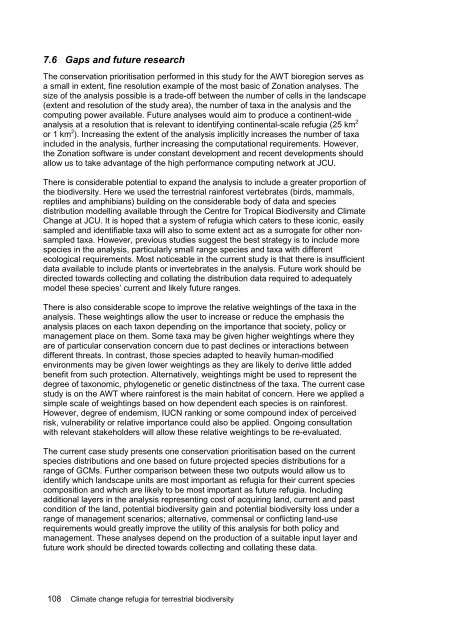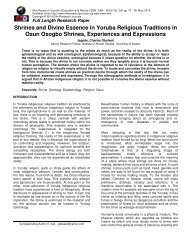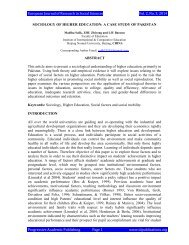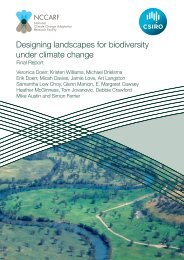Williams-Climate-change-refugia-for-terrestrial-biodiversity_0
Williams-Climate-change-refugia-for-terrestrial-biodiversity_0
Williams-Climate-change-refugia-for-terrestrial-biodiversity_0
Create successful ePaper yourself
Turn your PDF publications into a flip-book with our unique Google optimized e-Paper software.
7.6 Gaps and future research<br />
The conservation prioritisation per<strong>for</strong>med in this study <strong>for</strong> the AWT bioregion serves as<br />
a small in extent, fine resolution example of the most basic of Zonation analyses. The<br />
size of the analysis possible is a trade-off between the number of cells in the landscape<br />
(extent and resolution of the study area), the number of taxa in the analysis and the<br />
computing power available. Future analyses would aim to produce a continent-wide<br />
analysis at a resolution that is relevant to identifying continental-scale <strong>refugia</strong> (25 km 2<br />
or 1 km 2 ). Increasing the extent of the analysis implicitly increases the number of taxa<br />
included in the analysis, further increasing the computational requirements. However,<br />
the Zonation software is under constant development and recent developments should<br />
allow us to take advantage of the high per<strong>for</strong>mance computing network at JCU.<br />
There is considerable potential to expand the analysis to include a greater proportion of<br />
the <strong>biodiversity</strong>. Here we used the <strong>terrestrial</strong> rain<strong>for</strong>est vertebrates (birds, mammals,<br />
reptiles and amphibians) building on the considerable body of data and species<br />
distribution modelling available through the Centre <strong>for</strong> Tropical Biodiversity and <strong>Climate</strong><br />
Change at JCU. It is hoped that a system of <strong>refugia</strong> which caters to these iconic, easily<br />
sampled and identifiable taxa will also to some extent act as a surrogate <strong>for</strong> other nonsampled<br />
taxa. However, previous studies suggest the best strategy is to include more<br />
species in the analysis, particularly small range species and taxa with different<br />
ecological requirements. Most noticeable in the current study is that there is insufficient<br />
data available to include plants or invertebrates in the analysis. Future work should be<br />
directed towards collecting and collating the distribution data required to adequately<br />
model these species’ current and likely future ranges.<br />
There is also considerable scope to improve the relative weightings of the taxa in the<br />
analysis. These weightings allow the user to increase or reduce the emphasis the<br />
analysis places on each taxon depending on the importance that society, policy or<br />
management place on them. Some taxa may be given higher weightings where they<br />
are of particular conservation concern due to past declines or interactions between<br />
different threats. In contrast, those species adapted to heavily human-modified<br />
environments may be given lower weightings as they are likely to derive little added<br />
benefit from such protection. Alternatively, weightings might be used to represent the<br />
degree of taxonomic, phylogenetic or genetic distinctness of the taxa. The current case<br />
study is on the AWT where rain<strong>for</strong>est is the main habitat of concern. Here we applied a<br />
simple scale of weightings based on how dependent each species is on rain<strong>for</strong>est.<br />
However, degree of endemism, IUCN ranking or some compound index of perceived<br />
risk, vulnerability or relative importance could also be applied. Ongoing consultation<br />
with relevant stakeholders will allow these relative weightings to be re-evaluated.<br />
The current case study presents one conservation prioritisation based on the current<br />
species distributions and one based on future projected species distributions <strong>for</strong> a<br />
range of GCMs. Further comparison between these two outputs would allow us to<br />
identify which landscape units are most important as <strong>refugia</strong> <strong>for</strong> their current species<br />
composition and which are likely to be most important as future <strong>refugia</strong>. Including<br />
additional layers in the analysis representing cost of acquiring land, current and past<br />
condition of the land, potential <strong>biodiversity</strong> gain and potential <strong>biodiversity</strong> loss under a<br />
range of management scenarios; alternative, commensal or conflicting land-use<br />
requirements would greatly improve the utility of this analysis <strong>for</strong> both policy and<br />
management. These analyses depend on the production of a suitable input layer and<br />
future work should be directed towards collecting and collating these data.<br />
108 <strong>Climate</strong> <strong>change</strong> <strong>refugia</strong> <strong>for</strong> <strong>terrestrial</strong> <strong>biodiversity</strong>






